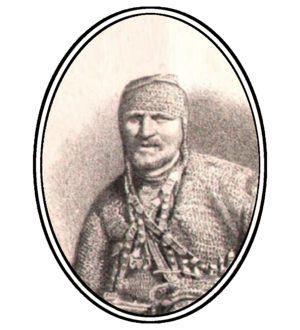Ale Khirtsizhiqo
Ale Khirtsizhiqo | |
|---|---|
 | |
| Native name | Хъырцыжъыкъо Алэ |
| Born | 18th c. Shakh, Circassia |
| Died | 1836 Circassia |
| Allegiance | |
| Battles/wars | Russo-Circassian War |
Ale Khirtsizhiqo (Adyghe: Хъырцыжъыкъо Алэ, romanized: Xhırtsıjzıqo Alə) was a Circassian military commander from the Abdzakh region who took part in the Russo-Circassian War.[1][2][3][4][5]
Biography
[edit]Early life
[edit]
Not much is recorded about Khirtsizhiqo's early life, as Circassians did not write down their history, and all knowledge comes from Russian sources. Sources state that he was born in the village of Shakh, and was of the Janchate clan. His birth date is unknown, but records show he joined a campaign against the Don Cossacks as a young man in 1776.
Russo-Circassian War
[edit]Rise to Fame
[edit]Khirtsizhiqo quickly became famous for his military successes. Ghish Nuh described him as follows:[6]
The most prominent characteristics of Khirtsizhiqo Ale and his close companions are not hatred and revenge but bravery and humor. In their lives, courage and jokes are so intertwined that if you didn't know better, you'd think they were playing with the enemy. Fear never crosses their minds, nor is it seen in their actions. When they encounter a problem in achieving their goals, one of their friends always finds a way out. Khirtsizhiqo Ale is always at the forefront as a leader and commander. He manages the most challenging tasks, and his friends are always by his side. They watch him closely and never lag behind in bravery. While Ale commands his soldiers in battle, his friends tackle a significant problem in the meantime.
Waving the Circassian Flag
[edit]In 1830, the Circassian flag was designed by Seferbiy Zaneqo.[7] When the first copy of the flag arrived in Circassia, it was received by Nur Muhammad Haghur and brought to the Gesh Valley, located in present day Sochi. Here, the chiefs of all Circassian provinces gathered and accepted the flag, and Commander Khirtsizhiqo Ale became the first person to hoist the flag on Circassian soil.[8]

Hostilities with Zass
[edit]In 1833, Grigory Zass was appointed as the commander-in-chief of the Russo-Circassian War and arrived at the Kuban Line with full authority.[10] Zass was infamous for his hatred of the Circassians.[11] He boasted in letters to his friends about massacring Circassian civilians.[12] Zass's main headquarters was in the Prochnyi Okop fortress. Wanting to strike a blow against Zass, Khirtsizhiqo Ale, along with his comrades from the Circassian army, attacked this base and kidnapped General Zass's daughter. Three years later, they sent a letter to Zass informing him that they would return his daughter, and they agreed on the terms and location of the exchange. Circassian mediators arrived at the agreed time and handed over the girl, dressed in Circassian attire, to her father. The girl convinced her father to pardon the Circassians, and both sides returned to their bases.[13][14][6]
Surrounded by Russian Forces
[edit]One night, while Khirtsizhiqo Ale and Aljeriyeqo Kushuk were camped in the field, they were surrounded by the Russian army. In the morning, both commanders led the charge to break the siege. Upon taking count, they saw that all their comrades were alive, but Aljeriyeqo Kushuk's servant was missing. Khirtsizhiqo Ale single-handedly charged into the Russian forces and rescued the servant, escaping without any casualties.[6]
Death
[edit]In 1836, while returning from a raid near the modern-day city of Cherkessk, Ale and 41 of his closest comrades, including prominent warriors, were ambushed by Grigory Zass's forces. All of them were killed and buried in the same location.[1][2][3][4][5][6]
References
[edit]- ^ a b Açumıj, Hilmi (2021). "Milletin Özgürlüğü İçin Canla Başla Mücadele Ettiler!". cherkessia.net. Archived from the original on 2021-08-15. Retrieved 2021-08-15.
- ^ a b Peneshu, Asker. Khirtsizhiqo Ale
- ^ a b Пэнэшъу, Аскэр. "Лъэпкъым ишъхьафитныгъэ псэемыблэжьэу фэбэнагъэх — Адыгэ макъ" (in Russian). Archived from the original on 2021-08-15. Retrieved 2021-08-15.
- ^ a b НэпшIэкъуй, Амин. "Тибыракъ мамырэу къытшъхьащэрэт!". Koshvesti. Archived from the original on 2021-08-15. Retrieved 2021-08-15.
- ^ a b "- АДЫГЭ ПСАЛЪЭ - ФИФI ФЫМЫГЪЭПУД, ФИ IЕЙ ФЫМЫГЪЭПЩКIУ". Retrieved 2021-08-15.
- ^ a b c d "Çetao İbrahim | KAHRAMANLARIMIZI TANIYALIM (2) - HIRTSIJIKO ALE". Cherkessia.net (in Turkish). 13 May 2014. Retrieved 2024-09-02.
- ^ Bashqawi, Adel (2017-09-15). Circassia: Born to Be Free. Xlibris Corporation. ISBN 978-1-5434-4765-1.
- ^ "-". www.vostlit.info. Retrieved 2024-09-02.
- ^ Цуекъо, Алый (2012). Circassian Family Names And Emblems [Circassian Family Names And Emblems] (in Adyghe). Maykop. p. 149.
{{cite book}}: CS1 maint: location missing publisher (link) - ^ "Jembulat Bolotoko: The Prince of Princes (Part One)". jamestown.org. Retrieved 2024-09-02.
- ^ Richmond, Walter (2013-04-09). The Circassian Genocide. Rutgers University Press. ISBN 978-0-8135-6069-4.
- ^ Colonel Grigory Zass. Letter to Baron Rosen. 25 February 1834. P. Boutkov, Materials for the New History of the Caucasus – Part I
- ^ Shalakho, Abu. "Literaturer, Pıunığer"
- ^ "General Zass'ın Kızının Adigeler Tarafından Kaçırılışı. – ÇERKES-FED" (in Turkish). 2020-04-17. Retrieved 2024-09-02.
